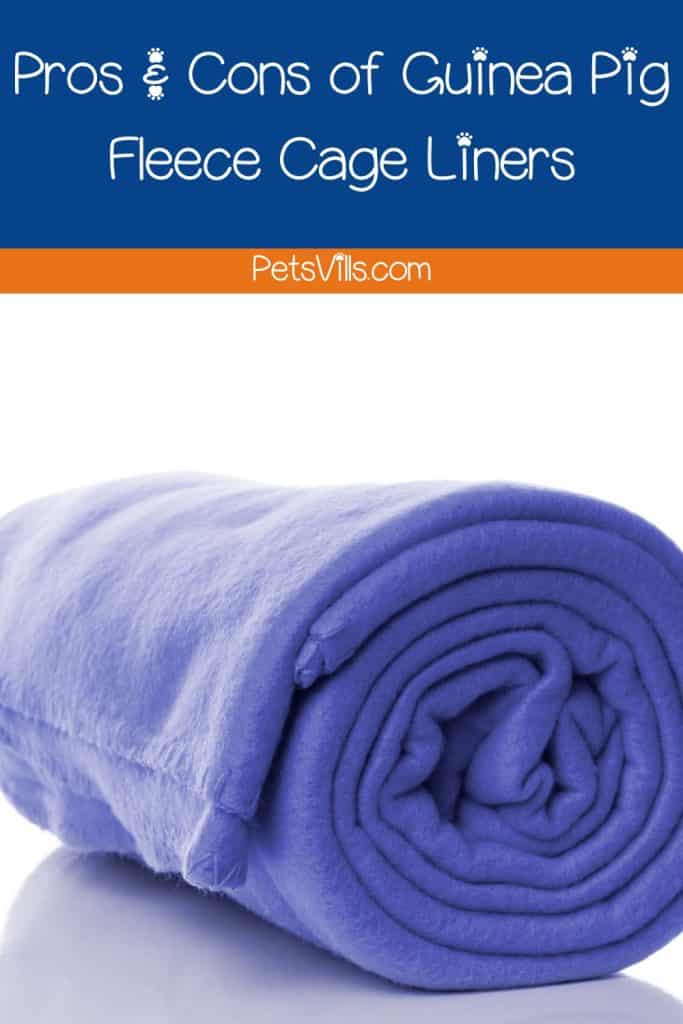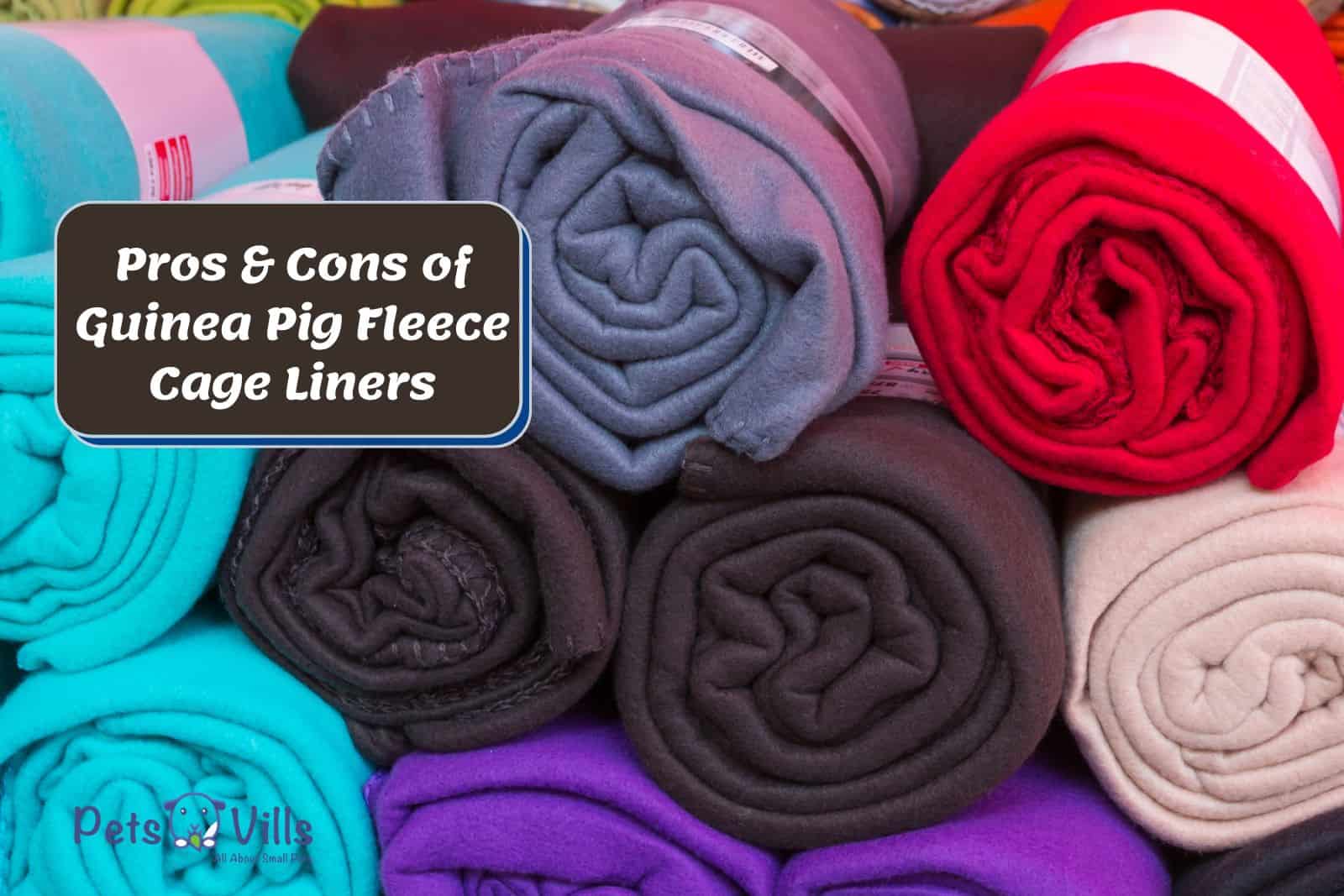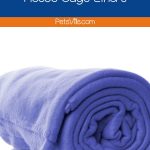Coveting an answer to “Pros and Cons of Guinea Pig Fleece Cage Liners“? You’re in luck!
Being an owner of multiple guinea pigs, I’ve spent countless hours researching, attending courses, watching videos, and consulting experts to unravel the mysteries of this popular bedding choice – fleece liners.
In this comprehensive guide, I’ll delve into the pros and cons of guinea pig fleece cage liners, providing valuable insights (a user-friendly option you won’t find elsewhere!) to help you make the best decision for your furry friend.
Keep reading to learn exactly what I’ve learned – I’ll save you the hassle!
Table of Contents
Key Takeaways
- Shifting from the traditional, fleece cage liners have emerged as a modern and preferred bedding option, offering a snug and comfortable space for your guinea pig’s activities.
- Guinea pig bedding offers aesthetic appeal, customization options, and long-term cost savings.
- Fleece liners are eco-friendly, easy to clean, and do not pose health problems like dust or harmful scents.
Excited to get started? Let’s get going with the pros and cons…
Pros and Cons of Guinea Pig Fleece Cage Liners
Fleece cage liners have many pros – here’s what I love about them…
7 Pros of Using Fleece Cage Liners
#1 Aesthetics
The beauty of fleece liners lies in their diverse colors and patterns, bringing a charming aesthetic touch to your guinea pig’s dwelling.
You can choose designs that reflect your style or even match your home’s decor.
#2 Comfort and Warmth
Guinea pigs have an innate affinity for cozy retreats, and the fleece liner, with its softness and warmth, serves as the perfect snug haven.
The thick fabric offers excellent cushioning for their small bodies, protecting them from the hard cage floor.
#3 Doesn’t Cause Health Problems
Unlike other types of bedding, fleece liners do not generate dust, a common problem that can lead to respiratory issues in guinea pigs.
#4 Cost-effectiveness Over Time
While the upfront cost of fleece liners can be higher than other bedding types, they offer long-term savings.
Fleece liners are reusable and can last for years if properly maintained, making them a more economical choice in the long run [1].
#5 Can be Custom-Made
Another advantage of fleece cage liners is that they can be custom-made to fit any cage size. This ensures a perfect fit for your guinea pig’s home.
#6 Environmental Friendliness
Unlike disposable bedding, fleece liners can be washed and reused, significantly reducing waste. They are an excellent choice for environmentally conscious pet owners.
#7 Ease of Cleaning
Fleece liners can be shaken, machine washed and dried, making cleanup relatively easy.
They also don’t generate dust, a common problem with other bedding types that can lead to respiratory issues in guinea pigs.
Now for the cons…
5 Cons of Using Fleece Cage Liners
#1 Some Guineas like the taste of too much
Here’s a truth bomb – some guineas develop a taste for gnawing on fleece liners, making it a less suitable bedding option in such cases.
Dr. Nancy Alperson, a renowned veterinarian, recommends using soft bedding for guinea pigs, such as fleece liners.
However, she cautions, “You can have really nice fleece liners, but if you see your guinea pigs eating them, you should not have those in there. You should take them away. [2]“
#2 More Expensive to Start
The upfront cost of fleece liners is higher than most disposable bedding options. However, they can be more cost-effective over time due to their durability and reusability.
#3 Requires Preparation
Unlike disposable bedding, fleece liners require some preparation before being used.
They must be washed and “wicked” — ensuring the fleece properly wicks away moisture — before they suit your pet.
#4 Frequent Spot Cleaning
Fleece liners need frequent spot cleaning to remove droppings and uneaten food. This can be a bit more labor-intensive compared to simply replacing disposable bedding.
#5 Potential Issues with Quality
The quality of fleece liners can vary between different brands, and lower-quality products may be more prone to issues like pilling, which can affect their durability and comfort.
Here’s a nifty comparison table highlighting the advantages and drawbacks of using fleece cage liners for your guinea pig:
| Pros of Using Fleece Cage Liners | Cons of Using Fleece Cage Liners |
|---|---|
| Aesthetics – Diverse range of colors and patterns, bringing a charming aesthetic touch to your guinea pig’s dwelling. | Some Guineas like the taste too much – Some guinea pigs may develop a taste for gnawing on fleece liners. |
| Comfort and Warmth – Softness and warmth provide a cozy retreat for guinea pigs. | More Expensive to Start – Higher upfront cost compared to disposable bedding options. |
| Doesn’t Cause Health Problems – No dust generation, reducing the risk of respiratory issues. | Requires Preparation – Fleece liners need to be washed and “wicked” before use. |
| Cost-effectiveness Over Time – Reusable and long-lasting, offering long-term savings. | Frequent Spot Cleaning – Requires regular cleaning to remove droppings and food. |
| Can be Custom-Made – Customizable to fit any cage size. | Potential Issues with Quality – Varying quality between brands, lower-quality products may have durability and comfort issues. |
| Environmental Friendliness – Washable and reusable, reducing waste. | |
| Ease of Cleaning – Shaken out, machine washable and dried, making cleanup relatively easy. |
Pro Tip: Want the perfect cage liner? You can grab a classy cage liner – perfect for your guinea family!
What are Guinea Pig Fleece Cage Liners?
Challenging traditional bedding options like wood shavings or paper products, fleece cage liners have positioned themselves as a novel and favored alternative.
These liners are essentially layers of fabric, often with an absorbent middle layer, that line the bottom of your guinea pig’s cage.
In fact, a study in the Manual of Exotic Pet Practice suggests that “Guinea pigs are best housed in well-ventilated, wire-sided cages with solid bottoms” [3].
And how do people achieve this? One way is by using fleece. Fleece has become popular due to its softness, providing a comfortable surface for your guinea pig to rest and play on.
Not only is it an exceptional bedding option for guineas, but once it became popular, it quickly gained the trust of many guinea pig owners, solidifying its place as a go-to bedding solution.
For more information on using fleece liners, check out this nifty video:
3 Types of Fleece Bedding
Each type has its unique features, and the best choice depends on your individual needs and your guinea pig’s comfort:
1. Single-Layer Fleece:
This is the simplest type of fleece bedding. It’s just a single layer of fleece fabric you can cut to fit your cage. However, it’s less absorbent than other options and may require a porous layer underneath.
2. Fleece Flippers:
These are panels made of fleece and an absorbent layer that can be flipped over for extended use between washings. They’re easy to clean and convenient but can be more expensive.
3. GuineaDad Fleece Liner:
This premium fleece liner has a built-in pocket for guinea pigs to burrow in. It’s highly absorbent and comfortable, but it’s also one of the more expensive options.
You probably have some questions about using fleece bedding for your guinea pigs. I’ve answered some of the most frequently asked questions below.
FAQs
1. Why do people use fleece as bedding for guineas?
Fleece is used as bedding for guinea pigs due to its softness, warmth, and cost-effectiveness over time. It’s also easy to clean and environmentally friendly.
2. Are fleece cage liners safe for guinea pigs?
Yes, fleece cage liners are safe for guinea pigs. However, some guinea pigs may be allergic to fleece or the detergent used to clean it.
3. How often should I change my guinea pig’s fleece cage liner?
You should change and wash your guinea pig’s fleece cage liner at least once a week. However, spot cleaning should be done daily to maintain a clean environment.
4. What are some alternatives to fleece cage liners for guinea pigs?
Alternatives to fleece cage liners include paper-based bedding, aspen shavings, and hay.
Each option has its own advantages and drawbacks, and the best choice will depend on your specific circumstances and your guinea pig’s preferences.
Conclusion
Knowing about the pros and cons of guinea pig fleece liners is magnificent. But before I leave you in the cold, I’ll give you the nutshell version:
Fleece cage liners for guinea pigs come with many advantages, such as unparalleled comfort, economical in the long run, and an eco-friendly approach.
However, they also have a few drawbacks, such as a higher initial cost, the need for regular washing, and the lack of availability in traditional pet stores.
As a guinea pig owner, you’ll need to weigh these pros and cons to decide if fleece cage liners are the best choice for your pet.
Remember, providing your furry friend a safe, comfortable, and clean environment is the most important thing.
Whatever bedding you choose, be sure it’s a decision made with your pet’s best interest in mind. After all, your guinea pig’s comfort and happiness truly matter.
Don’t see the answer you’re looking for? Feel free to drop a comment or reach out to me!

Resources
1. info@yourvetwantsyoutoknow.com. Guinea Pigs [Internet]. Your Vet Wants You to Know. 2022 [cited 2023 May 11]. Available from: https://yourvetwantsyoutoknow.com/guinea-pigs/
2. Hossain, et al. S. An approach to improve the pilling resistance properties of three thread polyester cotton blended fleece fabric. Heliyon [Internet]. 2021 [cited 2021 Jul 19];7:e06921. Available from: https://www.sciencedirect.com/science/article/pii/S2405844021010240
3. Riggs SM. GUINEA PIGS. Manual of Exotic Pet Practice. 2009;456–73.
Alina Hartley is a small-town girl with a ginormous love of bearded dragons. It all started with Winchester, a baby bearded who was abandoned at the shelter by his former owners because of a birth defect that caused one front leg to be shorter than the other. Alina originally went to the shelter looking for a guinea pig, but one look at Winchester and it was love at first sight. From that day on, Alina has dedicated her life to learning everything she can about bearded dragons. She loves helping new beardie parents start their incredible journey with these magnificent reptiles.
Follow her on:
LINKEDIN
TWITTER.
Read her latest articles HERE
Learn more about her HERE.


